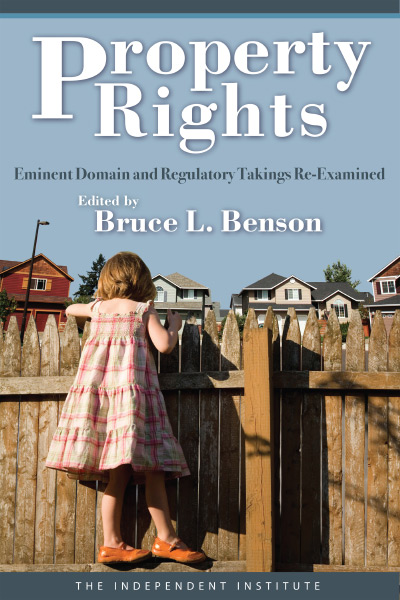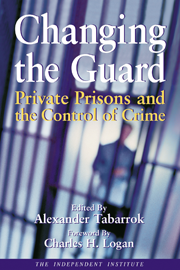| List Price: | ||
| Price: | $25.50 | |
| Discount: | $4.50 (Save 15%) |
| Formats |
Paperback |
Hardcover |
| List Price: | ||
| Price: | $25.50 | |
| Discount: | $4.50 (Save 15%) |
| Formats |
Paperback |
Hardcover |
Overview
The U.S. Supreme Court decision in Kelo v. City of New London has become a dramatic focal point for the abuse of eminent domain by the government, and has resulted in a widespread backlash. State legislatures all over the country have responded to the backlash by considering, and often attempting to impose, new constraints on the ability of local governments to take property from one private party and transfer it to another. Property Rights now provides an in-depth and critical examination of the uses and abuses of eminent domain and regulatory takings.
Property Rights explores the uses and abuses of eminent domain and regulatory takings in four areas: proposed constraints on the use of eminent domain, compensation issues in theory and practice, eminent domain from a public choice perspective, and the spillover costs of takings. This comprehensive book brings together an outstanding group of scholars and experts, including the attorney who represented Susette Kelo before the U.S. Supreme Court, the legal scholar who wrote Regulatory Takings, and experts on land value determination, land-use policy, environmental regulation, regulatory policy, entrepreneurial activities, and economic behavior.
Contents
1. Introduction: Eminent Domain, Regulation, and the Takings Backlash
Bruce L. Benson
2. Assembling Land for Urban Redevelopment: The Case for Owner Participation
Steven J. Eagle
3. The Proper Uses of Eminent Domain for Urban Redevelopment: Is Eminent Domain Necessary?
Samuel R. Staley
4. Compensation for Taking When Both Equity and Efficiency Matter
Paul Niemann and Perry Shapiro
5. How Fair Is Market Value? An Appraiser’s Report of Temptations, Deficiencies, and Distortions in the Condemnation Process
Wallace Kaufman
6. The Inadequacy of the Planning Process for Protecting Property Owners from the Abuse of Eminent Domain for Private Development
Scott G. Bullock
7. The Limits of Backlash: Assessing the Political Response to Kelo
Ilya Somin
8. Eminent Domain for Private Use: Is It Justified by Market Failure or an Example of Government Failure?
Bruce L. Benson and Matthew Brown
9. Land Grab: Takings, The Market Process, and Regime Uncertainty
Peter J. Boettke, Christopher J. Coyne, and Peter T. Leeson
10. The Adverse Environmental Consequences of Uncompensated Land-Use Controls
Jonathan H. Adler
11. Markets versus Takings and Regulation: Deciding the Future of the Past
Matthew Brown and Richard L. Stroup
12. Below-Market Housing Mandates as Takings: Measuring their Impact
Tom Means, Edward Stringham and Edward López
13. Conclusion: Instability and Inefficiency Are the Inevitable Results of Government Planning and Regulatory Implementation
Bruce L. Benson
Detailed Summary
- Its official name is eminent domain, but many voters call it theft. A political backlash followed the controversial 2005 U.S. Supreme Court decision that upheld the taking of Suzette Kelo’s home in Connecticut so that a private developer could turn the property into a more lucrative tax generator for the city. In response to the public outcry, 35 states enacted reforms after Kelo v. City of New London. In 2006, Arizona voters passed Proposition 207, the Private Property Rights Protection Act, which requires the payment of compensation for government takings through land-use regulation. How far will the political backlash go? Will it correct the perceived problems?
- Condemning property to clear the way for redevelopment alienates the property owner and should be avoided. Alternatives to condemnation can reduce the uncompensated losses that owners of condemned property now suffer. They can also reduce the opportunistic use of eminent domain to primarily benefit developers and public officials. Three such alternatives examined in Property Rights are: (1) giving existing owners an equity stake in the redevelopment entity, (2) requiring municipalities to substitute foreclosure proceedings for property condemnation, and (3) transferring zoning authority over neighborhoods to supermajorities of landowners in those neighborhoods.
- A review of recent eminent domain cases shows that governments routinely violate sensible guidelines that would discourage the abuse of eminent domain. Those guidelines recommend that a taking meet five conditions: (1) it is the method of last resort, (2) holdout problems are demonstrated, (3) the resulting redevelopment project will have broad public benefits, (4) the takings process is transparent, and (5) true economic blight is present.
- Each step in the eminent domain process is often corrupted by chance or on purpose. Those steps include the city’s preliminary appraisal and negotiation probe, the offer and counter offer, the final offer, condemnation, the owner’s surrender or court challenge, and the trial. Understanding how and where the process goes wrong is crucial to correcting the perceived problems.
- The planning process does not provide meaningful checks on abusive condemnations for private economic development. Contrary to the U.S. Supreme Court’s majority opinion in Kelo, the existence of a redevelopment plan and a planning process does little to curb the use of eminent domain to build private development projects sought by cities to boost their tax revenue and improve the overall economic health of their communities. Until Kelo is either overturned or substantially modified, property owners must continue to look to state constitutions, new state laws, and grassroots activism to protect themselves from the misuse of one of the most powerful tools a government has at its disposal.
- Reforms passed in the wake of the Supreme Court’s Kelo decision were largely inadequate. Of the reforms enacted by 37 state legislatures, 21 were largely symbolic in nature, providing little or no protection for property rights. Only seven states where eminent domain had been used significantly have enacted post-Kelo legislative reforms with any real teeth. The federal government enacted limited reforms, but those are likely to be no more effective than most of the state laws. Citizen-initiated ballot measures have led to the passage of much stronger laws than those enacted through referenda initiated by state legislatures.
In 2005, the U.S. Supreme Court reaffirmed the authority of local governments to transfer property to private developers. The Court’s decision in the landmark case, Kelo v. City of New London, was controversial and prompted several states to enact legislation that voters hoped would limit the scope of eminent domain. In some states, so-called regulatory takings—reductions in the value of private property resulting from government regulations—also came under fire.
Which criticisms of eminent domain and regulatory takings have interested economic and legal experts the most? How might the problems associated with government takings be remedied? Is meaningful reform more likely to come from legislatures or from the courts? These questions are answered in Property Rights: Eminent Domain and Regulatory Takings Re-Examined.
Edited by Bruce L. Benson (Florida State University), Property Rights offers penetrating analyses of government takings, although the degree of criticism varies from contributor to contributor. The views expressed range from proposals to “mend, not end” the takings process to the contention that involuntary takings are incompatible with “just compensation.” The book amounts to a powerful economic and legal critique of government takings of private property.
“While some of the authors of chapters in this volume might not agree, the implication of these chapters as a group seems quite clear to this editor,” writes Benson in his introduction. “Those who are advocating limitations on government’s taking powers are correct—much more significant limitations on government takings power should be imposed.”
Reforming Eminent Domain after Kelo
How should eminent domain be reformed in light of the Supreme Court’s Kelo decision? The question assumes that eminent domain has significant problems that could be fixed. Steven J. Eagle (George Mason University School of Law) is one who believes that eminent domain is a desirable tool to overcome otherwise insurmountable transactions costs of assembling large parcels of land for private development, but he objects to many of its results. To promote fairness, he recommends that property owners be given real opportunities for planning and equity participation in redevelopment.
Supporters of eminent domain claim it is necessary for redevelopment, but Samuel R. Staley (Director of Urban and Land Use Policy at the Reason Foundation) takes issue with that assumption. The real purpose of eminent domain, he argues, is to enable private developers to acquire land while avoiding market transactions. Staley proposes five requirements that a government taking should meet. He also shows that recent takings for redevelopment have rarely met them.
Unfair Compensation
The two previous chapters suggest that part of the problem with eminent domain is that compensation amounts may be inadequate, a violation of the Fifth Amendment requirement that “just compensation” be paid for taking private property for public use. The next two chapters deal more directly with problems that arise when trying to determine compensation.
Economists Paul Niemann and Perry Shapiro (both of the University of California, Santa Barbara) point out that the current basis for determining compensation—the property’s pre-takings “market value”—creates a moral-hazard problem and induces inefficient investments. They offer an alternative method: pay property owners an amount equal to the post-development value of the land. This method can encourage efficient resource use.
Wallace Kaufman, an expert on land-value determination who has frequently testified in takings cases, emphasizes a different problem with the “market value” definition of “just compensation.” Both the appraisal process and the legal proceedings in eminent domain cases lead to distorted compensation amounts, but contrary to conventional wisdom, compensation often is high rather than low, due to political influence, the experience of lawyers, and other similar factors. Kaufman also stresses that the primary problem with eminent domain is that it leads to a loss of liberty.
The Politics of Eminent Domain
How well can the political process deal with problems arising from eminent domain? Scott G. Bullock (Senior Attorney at the Institute for Justice and Susette Kelo’s co-counsel before the U.S. Supreme Court) argues against the Court’s justification for allowing the Kelo takings. The planning process, he explains, is an inadequate substantive check on eminent domain; special interests exert tremendous influence on government planning.
Moreover, most of the state laws that were passed after Kelo to limit the use of eminent domain have been ineffective, according to Ilya Somin (George Mason University School of Law). The reason is two-fold: (1) the development interests that stand to benefit from takings are politically strong, and (2) most voters have weak incentives to engage in well-informed political action. Somin thus concludes that legislation will not effectively constrain the abuses of eminent domain.
Eminent domain is touted as a remedy to “the holdout problem,” but is the proposed remedy worse than the ailment it is supposed to correct? Economists Bruce L. Benson and Matthew Brown (Charles G. Koch Charitable Foundation) believe so. The problems associated with eminent domain likely far outweigh those of market failure, they argue. This is not surprising because the evolution of eminent domain and compensation law reflects an ongoing effort to constrain the state, rather than to solve problems of market failure. Benson and Brown conclude with a cautionary note: if eminent-domain powers were eliminated, government might substitute them with uncompensated regulatory takings.
More Pitfalls of Takings
Eminent domain also fosters other undesirable outcomes. One reason is that government takings change the rules under which entrepreneurs and other economic decision-makers operate. Rule changing in turn alters, often detrimentally, the opportunities that decision-makers face, explain economists Peter J. Boettke, Peter T. Leeson (both of George Mason University) and Christopher J. Coyne (West Virginia University).
Regulatory takings in the name of environmental protection, for example, often foster counterproductive outcomes, according to Jonathan H. Adler (Case Western Reserve University School of Law). The failure to compensate private landowners for the costs of environmental regulations has discouraged voluntary conservation and encouraged the destruction of environmental resources. It has lowered the government’s cost of land-use regulation and thereby discouraged the use of other environmental protection measures.
The use of regulatory takings to serve the goal of historical preservation has also resulted in undesirable outcomes. Matthew Brown and Richard L. Stroup (the Property and Environmental Research Center and North Carolina State University) explain that the use of eminent domain and/or regulation to force historical preservation allows interest groups, including those with competitive or NIMBY (“Not in my backyard”) concerns, to pursue their objectives by shifting costs to taxpayers, landowners, and those who seek housing or other economic development. The possibility of cost shifting creates incentives for some parties to use the takings process and creates incentives for landowners to hide or destroy historic remnants.
Next, economists Tom Means, Edward J. López (both of San Jose State University) and Edward Stringham (Trinity College) look at how house prices are increased by inclusionary zoning, i.e., requirements that developers set aside a percentage of their housing units to be sold at a below-market prices. Using California data, the authors estimate that these requirements drive up overall housing prices by 20 percent. They also show that cities with inclusionary zoning typically end up with 10 percent fewer housing units, relative to cities without such mandates.
The Failures of Government Planning and Regulation
As with eminent domain, regulatory takings inevitably fail to do much of what its supporters claim they will do. Bruce L. Benson and Matthew Brown return in the concluding chapter to argue that government regulation undermines market efficiency because it leads to constant—and costly—changes in rules, as competition to avoid and/or alter them plays out in markets, legislatures, bureaucracies, and the courts.
Many of the most significant costs are not even measurable, such as the diversion of entrepreneurial activity toward regulatory avoidance. Benson and Brown look closely at one instance of regulatory avoidance—recurring political resistance to Oregon’s comprehensive planning and land-use regulations.
“What is being observed is a continuous struggle to restrain the powers of the state to take and transfer property,” write Benson and Brown. “Those who advocate government takings powers, whether it involves compensation under eminent domain or uncompensated regulatory takings, are essentially arguing that the state actually owns all property, and that the private citizens who claim to have property rights to parcels of property are simply stewards of the state.”
Praise
“The Supreme Court’s controversial decision in Kelo v. New London has produced not only a backlash against eminent domain abuse, but now, with the path-breaking book, Property Rights, a serious scholarly challenge to the premises underlying even non-abusive claims for eminent domain. Some of the best scholars and litigators in the field are assembled here to give their very insightful re-assessment of, and challenge to, the ‘despotic power’ of eminent domain.”
—John C. Eastman, Donald P. Kennedy Chair in Law and former Dean, Chapman University School of Law
“Professional and lay readers alike can profit from the different perspectives contained in this comprehensive and thoughtful book edited by the energetic Bruce Benson.”
—Richard A. Epstein, Laurence A. Tisch Professor of Law, New York University; author of Takings: Private Property and the Power of Eminent Domain
“The authors of Property Rights plausibly contend that government initiatives to ‘correct market failures’ commonly make matters worse. This book is a welcome counterweight to the writings of unabashed enthusiasts of government efforts to redevelop cities and micromanage the environment.”
—Robert C. Ellickson, Walter E. Meyer Professor of Property and Urban Law, Yale University
“Property Rights makes a valuable contribution to the public debate that has swept the country in the wake of the Supreme Court’s widely criticized decision in Kelo v. City of New London, and contributes to the understanding of the competing contentions of those who respectively favor and oppose the use and misuse of eminent domain.”
—Gideon Kanner, Professor Emeritus of Law, Loyola Marymount University
Author
Bruce L. Benson is Senior Fellow at The Independent Institute, the DeVoe Moore Distinguished Research Professor of Economics at Florida State University, and Contributing Editor of The Independent Review. He is the author of To Serve and Protect: Privatization and Community in Criminal Justice.
News
| Property Rights: Eminent Domain and Regulatory Takings Re-Examined edited by Bruce L. Benson, reviewed by P.J. Hill in Faith & Economics (Fall 2012) | Mon., Oct. 15, 2012 | |
| “Senior Fellow Bruce Benson interviewed regarding his book, Property Rights” (ABC Australia Radio) | Fri., Nov. 11, 2011 | |
| “Interview with Senior Fellow Bruce Benson on his book, Property Rights” (Kosmos Podcast) | Thu., Oct. 14, 2010 | |
| “New Book on Eminent Domain and Property Rights” (Foundations of Economics) | Wed., Sep. 8, 2010 | |
| “New Eminent Domain Publication: Property Rights” (Florida Eminent Domain Blog) | Mon., Aug. 16, 2010 | |
| “New Book on Eminent Domain and Property Rights Available” (Make Differences) | Thu., Jul. 8, 2010 | |
| “Property Rights: Eminent Domain and Regulatory Takings Re-Examined” (Intellectual Takeout) | Sat., May. 15, 2010 |















